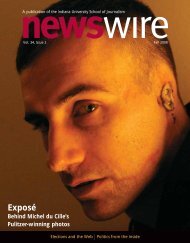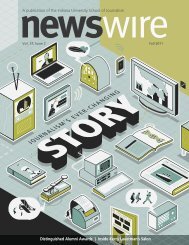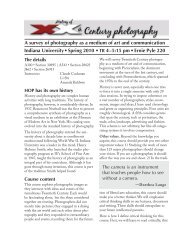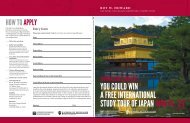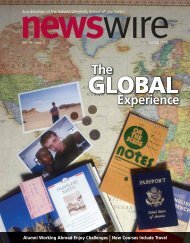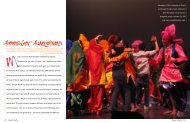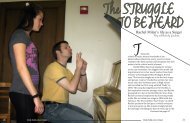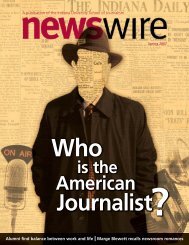The changing face of photojournalism - Indiana University School of ...
The changing face of photojournalism - Indiana University School of ...
The changing face of photojournalism - Indiana University School of ...
- No tags were found...
Create successful ePaper yourself
Turn your PDF publications into a flip-book with our unique Google optimized e-Paper software.
featurestoryCowboy Jo Jo LeMond practices his ropingtechniques before a rodeo at the NationalWestern Stock Show in Denver, Colo.Matt McClain, BAJ’98Degree: BAJ’98Location: Denver, Colo.Employers/clients: Ventura CountyStar, Rocky Mountain News,Wall Street JournalSelected awards/accomplishments:2008 Scripps Howard FoundationNational Journalism Award forPhotojournalism; 2010 World PressPhoto, second place, Daily LifePicture StoryAdvice: “Patience. I know I’ve gotmost pseudo-pr<strong>of</strong>essionals beat becausethey’re not crazy enough to wait hoursfor one picture.”Website: www.mattmcclainphoto.comSteve RaymerMatt McClain was at an unemployment<strong>of</strong>fice photographing laid-<strong>of</strong>f naturalgas workers the day he received thenews his paper was closing. <strong>The</strong> RockyMountain News in Denver was a nationallyacclaimed paper, known as much forits stirring pictures as for its hard newsreporting. Among Denverites, it went bythe moniker “<strong>The</strong> Rocky.”<strong>The</strong> paper, owned by the E.W. ScrippsCo., had won four Pulitzer Prizes sincethe year 2000, including one for photography.But it was also suffering from thesame forces as other newspapers acrossthe country. Unable to find a buyer, theScripps Co. announced on Feb. 26, 2009,that its final print edition would run thenext day.“After I got the call, I went back to thehotel and filed my pictures,” says McClain.“It took awhile for the news to sink in.”Always the journalist, McClain returnedto Denver to cover the closing <strong>of</strong> thepaper he had called home for three years.He also had to turn in his photo equipment,which was when the meaning <strong>of</strong> itall hit him full force.“Equipment return was the hardestpart,” he says. “I felt so naked and vulnerable.<strong>The</strong> camera is <strong>of</strong>ten an emotionalshield, and I didn’t have that shield.”McClain’s story is as sad as any in theindustry, or it would’ve been if he hadn’tlearned to adapt. Instead, he’s taken hisyears <strong>of</strong> experience, his numerous awards,his patience and determination, and hisunflinching eye, and built a successful careeras a freelancer. He’s learned the businessside <strong>of</strong> <strong>photojournalism</strong>, and he’s talked toothers in the industry who already had madethe leap to freelance.“As a freelancer,” he says, “you have todo this weird balancing act where you takejobs that pay well so that you can do stuffthat’s more meaningful and have the time towork on your own projects.”You also have to start acting like a businessowner, he explains, because “that’sexactly what you are.”McClain’s editorial freelance work hasappeared in <strong>The</strong> Washington Post, <strong>The</strong> WallStreet Journal and <strong>The</strong> Denver Post. “Finding<strong>The</strong>ir Way,” a story that appeared in Peoplemagazine in November 2009, won secondplace for Daily Life Picture Story from WorldPress Photo.Still, McClain says he misses the life <strong>of</strong>the daily newspaper photographer. “I likewhat a newspaper <strong>of</strong>fers. I like workingevery day with people, the collaboration,planning, researching stories. That’s beenthe hardest transition. But that’s where theindustry is going.”< 26 > newswire // Fall Spring 2010 2010





